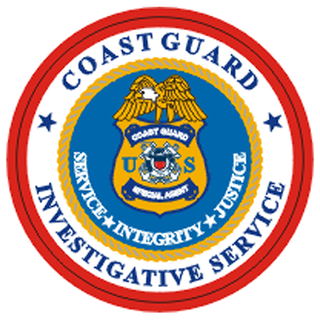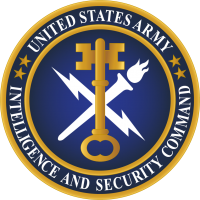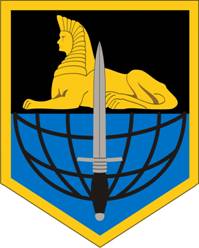
Counterintelligence (counter-intelligence) or counterespionage (counter-espionage) is any activity aimed at protecting an agency's intelligence program from an opposition's intelligence service. It includes gathering information and conducting activities to prevent espionage, sabotage, assassinations or other intelligence activities conducted by, for, or on behalf of foreign powers, organizations or persons.

SMERSH was an umbrella organization for three independent counter-intelligence agencies in the Red Army formed in late 1942 or even earlier, but officially announced only on 14 April 1943. The name SMERSH was coined by Joseph Stalin. The formal justification for its creation was to subvert the attempts by Nazi German forces to infiltrate the Red Army on the Eastern Front.

The United States Naval Criminal Investigative Service (NCIS) is the primary investigative law enforcement agency of the U.S. Department of the Navy. Its primary function is to investigate major criminal activities involving the Navy and Marine Corps, though its broad mandate includes national security, counterintelligence, counterterrorism, cyberwarfare, and the protection of U.S. naval assets worldwide. NCIS is the successor organization to the former Naval Investigative Service (NIS), which was established by the Office of Naval Intelligence after the Second World War.
The Department for Protection of the People, commonly known under its Serbo-Croatian acronym as OZNA, was the security agency of Communist Yugoslavia that existed between 1944 and 1946.

Ralph Henry Van Deman was a United States Army officer, sometimes described as "the father of American military intelligence." He is in the Military Intelligence Hall of Fame.

The Coast Guard Investigative Service (CGIS) is a division of the United States Coast Guard that investigates crimes where the U.S. Coast Guard has an interest. It is composed of civilian (GS-1811), active duty, reserve enlisted, and warrant officer special agents.
The History of the Counter Intelligence Corps was a classified 30 volume book prepared in the late 1950s by Major Ann Bray and others at the United States Army Intelligence Center and printed in 1959. The document contains the history of the US Army's Counter Intelligence Corps (CIC) until 1950. A declassified (sanitized) version of the official history is now available to researchers at the National Archives and Records Administration (NARA).

The Counter Intelligence Corps was a World War II and early Cold War intelligence agency within the United States Army consisting of highly trained special agents. Its role was taken over by the U.S. Army Intelligence Corps in 1961 and, in 1967, by the United States Army Intelligence Agency. Its functions are now performed by its modern-day descendant organization, United States Army Counterintelligence. The National Counter Intelligence Corps Association (NCICA), a veterans' association, was established in the years immediately following World War II by former military intelligence agents.

The Military Intelligence Corps is the intelligence branch of the United States Army. The primary mission of military intelligence in the U.S. Army is to provide timely, relevant, accurate, and synchronized intelligence and electronic warfare support to tactical, operational and strategic-level commanders. The Army's intelligence components produce intelligence both for Army use and for sharing across the national intelligence community.

The United States Department of the Army Criminal Investigation Division (CID), previously known as the United States Army Criminal Investigation Command (USACIDC), is the primary federal law enforcement agency of the United States Department of the Army. Its primary function is to investigate felony crimes and serious violations of military law and the United States Code within the US Army. The division is an independent federal law enforcement agency with investigative autonomy; CID special agents, both military and civilian, report through the CID chain of command to the CID Director, who reports directly to the Under Secretary of the Army and the Secretary of the Army. Unlike their counterparts at OSI and NCIS, Army CID does not have primary counterintelligence responsibilities.

The United States Army Intelligence and Security Command (INSCOM) is a direct reporting unit that conducts intelligence, security, and information operations for United States Army commanders, partners in the Intelligence Community, and national decision-makers. INSCOM is headquartered at Fort Belvoir, Virginia.
The counter-terrorism page primarily deals with special police or military organizations that carry out arrest or direct combat with terrorists. This page deals with the other aspects of counter-terrorism:
National governments deal in both intelligence and military special operations functions that either should be completely secret, or simply cannot be linked to the sponsor. It is a continuing and unsolved question for governments whether clandestine intelligence collection and covert action should be under the same agency. The arguments for doing so include having centralized functions for monitoring covert action and clandestine HUMINT and making sure they do not conflict, as well as avoiding duplication in common services such as cover identity support, counterespionage, and secret communications. The arguments against doing so suggest that the management of the two activities takes a quite different mindset and skills, in part because clandestine collection almost always is on a slower timeline than covert action.

The Military Security Agency is a Serbian military security and counterintelligence agency of Serbia, organizational unit of the Ministry of Defence.

United States Army Counterintelligence (ACI) is the component of United States Army Military Intelligence which conducts counterintelligence activities to detect, identify, assess, counter, exploit and/or neutralize adversarial, foreign intelligence services, international terrorist organizations, and insider threats to the United States Army and U.S. Department of Defense (DoD).

The 902nd Military Intelligence Group was a brigade-sized unit of the United States Army that operated under the command of the United States Army Intelligence and Security Command. Its primary focus was counterintelligence. The headquarters of the unit were located at Fort Meade, Maryland.

The Military Intelligence Division was the military intelligence branch of the United States Army and United States Department of War from May 1917 to March 1942. It was preceded by the Military Information Division and the General Staff Second Division and in 1942 was reorganised as the Military Intelligence Service.
The People's Commissariat for State Security or NKGB, was the name of the Soviet secret police, intelligence and counter-intelligence force that existed from 3 February 1941 to 20 July 1941, and again from 1943 to 1946, before being renamed the Ministry for State Security (MGB).
Directorate of Special Departments within NKVD USSR. rus. Управление Особых Отделов при НКВД СССР, (UOO) was an organization created in 1941 to conduct military counterintelligence under one command. The UOO was created to take back control from the retreating Red Army after the German invasion of the USSR and to counter German espionage efforts in the Soviet Armed forces. The principle tactic used by the UOO on Red Army personnel was intimidation and terror.














